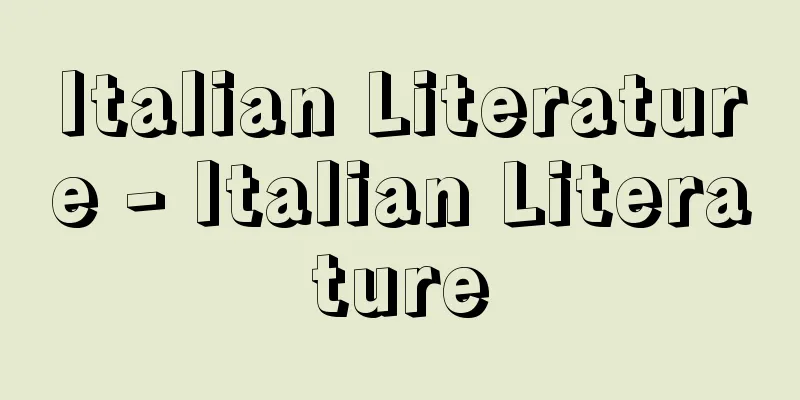Italian Literature - Italian Literature

Characteristics of Italian literatureThe Italian peninsula is located almost in the center of the Mediterranean world, and in the pre-Christian era, it had many Greek colonies, mainly in the south and on the island of Sicily, and built the so-called Magna Greccia (Great Greece) civilization. After the Christian era, the Romans developed a strong Latin culture based on Christianity, and for a long time it became the center of both the Eastern and Western worlds. Thus, for 2,000 years, from the 8th century BC to the 12th century AD, Italian literature directly inherited the flow of ancient Greek and Roman literature, and therefore, compared to other countries, it maintained the orthodoxy of European classical literature and always sought to return to the classics. A prime example of this is Italian Renaissance literature, which aimed to revive the spirit of ancient Greece through vernacular language. Later, for example, Alfieri in the first half of the 19th century, Foscolo, who was born on the island of Zante (Zakynthos), the Sicilian novelist Verga in the second half of the 19th century, and the resistance poet Quasimodo, who received the Nobel Prize in Literature in 1959, all called for a return to classical literature, and this revival became the basis for avant-garde techniques. As is well known, epic and lyric poetry were the foundation of ancient Greek and Roman literature. Therefore, the Italian literature also developed around epic poetry. The works of the greatest poets in European literature, such as Dante, Boccaccio, Ariosto, and Tasso, belong to this lineage. The world of lyric poetry, with Petrarch at its apex, has been the mother of thought and expression for Italian poets and novelists up until the 20th century. And, in either epic or lyric poetry, the core of Italian literary expression was, simply put, thought about "love." On the other hand, Italy achieved the unification of a modern nation later than the so-called great European powers such as France and England, and therefore retained the form of a medieval city-state until late, which resulted in a certain degree of delay in the field of literature in the modern era. In other words, modern novels, which can be said to be the product of bourgeois literature, did not develop sufficiently. During the Fascist period, when Italy attempted rapid modernization in order to catch up with the great powers in the political sphere, Italian bourgeois literature was achieving a certain level of development. However, this was crushed politically by the anti-fascist national movement, and literary by neorealism. Therefore, the tone of Italian literature after the Second World War has become anti-bourgeoisie literature, anti-novel, and literature of responsibility. The fact that neorealist literature was based on narrative and lyric techniques clearly represents the characteristics of modern Italian literature, which inherits the traditions of classical literature. [Hideaki Kawashima] The history of Italian literatureLiterature from the Middle Ages to the RenaissanceIn the late Middle Ages, when Latin was used exclusively as a written language and official language, the first literary expression in Italian was produced by an innovative religious figure: Saint Francis of Assisi's Canticle of the Creatures (1224/1225). In contrast to the orthodox preachers, centered around the Pope, who always used Latin, the poor religious man who dared to spread his message in the Italian vernacular was in a dangerous position where he could be turned to heresy if he was not canonized, so he relied on literature. It is safe to say that the seeds of Dante's sharp criticism of the corruption of the papacy in the vernacular Divine Comedy, written less than a century later, were already in embryo here. By the way, vernacular literature was already widely circulated in northern Italy at the beginning of the 13th century. Troubadours frequently brought literature in Oi and Occitan to the cities of northern Italy. At that time, Federico II of the Hohenstaufen family, whose court was in Palermo, Sicily, gathered talented writers from all over the country and actively adopted Provencal love poetry, which led to the rise of the Sicilian School. Federico II himself produced excellent vernacular poetry, but his true intention must be to confront the Papacy, the stronghold of Latin culture, with a new culture. Among the court poets of the Sicilian School were outstanding talents such as Giacomo da Lentini, who is said to be the originator of the sonnet (fourteen-line poem), but their theme was a debate over "love." However, with the fall of the Hohenstaufen, the Sicilian poets were dispersed, and their poetic style spread throughout northern Italy, where it subtly influenced the Bolognese poets, giving birth to the "New School" in Tuscany. The representative poet of this school was Dante Alighieri of Florence. He mixed lyric poetry with prose, wrote "Novum" (around 1293), and announced the opening of a new poetic horizon around "love." He combined this with the cosmological view of medieval theology to create the magnificent epic poem "Divine Comedy" in vernacular. In this work, which is based on the doctrine of the Trinity and travels through the three realms of hell, purgatory, and heaven in three-line rhymes, Dante, the poet who travels to the depths of hell while still alive, is guided by Virgil, the greatest poet in the Latin world. Virgil was born near Mantua in northern Italy, traveled to Greece, and was buried in Naples. Dante considered himself the heir to the epic tradition of Homer in Greece and Virgil in Latin, and also took pride in being an Italian poet who surpassed them. Moreover, Dante's final guide to heaven was Beatrice, the incarnation of "love." Dante's literature, which concluded medieval theology, was essentially built-in with a gaze towards the past, whereas Francesco Petrarch and Giovanni Boccaccio, who lived almost in the same era, completely changed their ideas about "love" - the former with Laura and the latter with Fiammetta - and took a big step towards modernity. In Dante's work, Beatrice, who is an allegory of "love," is always one with the light of heaven, but Laura in Petrarch's lyric poems laments the light that has been lost. Moreover, Fiammetta (which also means "little flame") is nothing but the inferno that burns Boccaccio's carnal desires. Boccaccio's masterpiece "Decameron" (c. 1349-1351) is, like "Divine Comedy", fixated on the perfect number 10 squared, i.e. 100, and takes the form of 10 days and 100 stories, but the theme "love" is not absolute, and has already been divided into "love", "luck" and "talent", and is beginning to depict the psychological world of modern novels. And the earthly, rather vulgar, harsh and everyday world depicted by Boccaccio, combined with the Renaissance spirit based on the human individual, gave birth to a lineage of short stories by Franco Sacchetti, Matteo Bandello and others, and also gave rise to the literature of Chaucer and Shakespeare outside the Italian peninsula. On the other hand, Petrarch's collection of lyric poems, Canzoniere (from around 1335 to his final years, the pre-Chigi edition was published in 1348), subtitled "Fragments of Vocabulary," develops a perfect, complex and profound world of poetic imagery, centered on sonnets, and has dominated the history of poetry for the next several hundred years. The so-called Petrarchism casts a deep shadow even on modern poetry, such as Ungaretti's collection of poems, The Promised Land (1950). However, in terms of the influence on later generations of Petrarch and Boccaccio, the ideas of humanism that these two men established and promoted cannot help but be pointed out as being more important. Humanism, which formed the basis of the 15th century Italian Renaissance, began with Petrarch and Boccaccio's excavation of classical texts and their rediscovery of Greek thought. The humanist movement, which was centered around the theme of harmonizing the classical ideas of ancient Greece and Latin with the Christian world, gave birth to Neoplatonism in Florence under the rule of the Medici family. Representative literary figures include Lorenzo de' Medici, who wrote poetry and was an active defender of culture, Angelo Ambrosini (known as Poliziano), and Luigi Pulci, who wrote the absurd Tale of the Knights of Morgante, a giant, in the same vein as Rabelais and Cervantes. The mixture of classical literature and medieval chivalric romance, which began with "Morgante" (1483), continued through Matteo Maria Boiardo's "Orlando in Love" (1499), the greatest epic poem of the Renaissance, Ludovico Ariosto's "Orlando Mador" (definitive edition 1532), Torquato Tasso's "Jerusalem Liberated" (1575), the greatest epic poem of the late Renaissance or Baroque period, and reached the pinnacle of technique in Giambattista Marino's long epic poem "Adone" (1623), which was called Marinismo. It can be said that Marinismo half suffocated the spirit of epic poetry since Dante in its complicated rhythm. The discovery of the individual human being brought about by the Renaissance liberated the human spirit from the shackles of religion, but at the same time brought to light more clearly the reality that the individual human being was a prisoner of the restrictive social system. The Renaissance man, now a free-minded person, portrayed the condition of the individual as a restricted being. Niccolo Machiavelli's The Prince (1513), Baldassare Castiglione's Discourses (1528), Pietro Aretino's Discourses (1534-1539), and Francesco Guicciardini's (1483-1540) Memoirs (1561-1564), along with the short stories and letters of Ariosto and Tasso, reveal the pathos, cunning, and clarity of free thinkers living in the difficult court society of despotic monarchs. The engraver Benvenuto Cellini, who was closer to a commoner or a scoundrel than to a courtier, also dictated his Autobiography (published in 1728) and revealed the true nature and limitations of Renaissance society. [Hideaki Kawashima] From Classicism to RomanticismAs mentioned above, from the 14th to the 16th centuries, Petrarch in poetry and Boccaccio in prose were role models for many poets and writers. However, the culture of the Italian peninsula, which was based mainly on the precarious balance of city-states, was prone to regionalism, and in order to protect the tradition of the "glorious vulgar language" that had existed since Dante, there were repeated discussions on maintaining the purity of language as a literary term. In 1525, Pietro Bembo wrote "De Vulgaria" in which he argued that the foundation of Italian literary language should be based on the language of 14th century Tuscan writers, especially Petrarch and Boccaccio. This was supported by the Florentine Academy of the Crusca (founded in 1583), and in 1612 the first "Dictionary of the Italian Language" was published. In literary expression, the extremely decorative Marinismo poetic style was all the rage, and in 1690 the Arcadia Academy was founded, which called for a return to the classics and a simple style of writing was valued. On the other hand, the impasse in Marinismo's writing was met with a breakthrough in drama, with Pietro Metastasio first creating melodrama by fusing comedy and tragedy. He also reformed the 16th century commedia dell'arte, an improvised masked play, and Carlo Goldoni created character plays based on the Venetian dialect, ushering in a new era in Italian comedy. Around the same time, Carlo Gozzi incorporated folk tales into his plays, and then Vittorio Alfieri drew on the classics as material to create a world of solemn tragedy. Then, at the end of the 18th century, various parts of Italy, which had been groaning under the rule of foreign powers at the time, were liberated one after another by the aftermath of the French Revolution and the conquest of Napoleon I. Although a republic was established at one time, they were once again oppressed by the old regime. In the midst of such historical changes, poets who produced excellent works despite being crushed by their own hopes and despair include Vincenzo Monti and Ugo Foscolo, who died in exile in the suburbs of London. In particular, Foscolo wrote the epistolary novel "The Last Letter of Jacopo Ortiz" (1802), based on the model of a young poet who was doubly betrayed by his love for his country and the love of a woman, and also lectured on the history of Italian literature, laying the foundation for future literary history. Italian Romanticism began with the literary activities of Foscolo in his later years, and in tandem with the movement for national unification (Risorgimento), produced two giants, Alessandro Manzoni and Giacomo Leopardi. In his work The Betrothed (1827), Manzoni portrayed a people that refused to succumb to foreign oppression, while at the same time confirming that the foundation of the Italian language was Tuscan, thus playing a major role in the spiritual unification of the modern Italian nation. [Hideaki Kawashima] From modern literature to contemporary literatureLeopardi, known as the world's most pessimistic poet, studied hard from a young age - he had already published a paper that would become famous at the age of 15 - and he died young from rickets, but his brilliant ideas of nihilism and his poetry had a profound influence on later generations. In the 20th century, Italy established Rome as its capital and completed its unification. This unification of the modern Italian state also brought about the end of Romantic literature. Or rather, it must be said that the disappointment of the people who were betrayed by the unified state was deep and great because the movement for national unification (Risorgimento) was an incomplete reform. In particular, southern Italy and Sicily suffered under oppression that was no less than that of the old regime, and a literature of verismo that depicted the stark image of such people arose. Giovanni Verga, a native of Sicily, used a new style of writing invented from Sicilian to depict the poor people who were neither blessed with the political benefits of the unified state nor the light of Christianity. It was only with Verga that Italian literature portrayed the lowest class of people in the world of knowledge. Therefore, in the process of absorbing the fin de siècle decadence, futurism, and Gabriele D'Annunzio's adventurism, which were widespread after unification, into Fascism along with the avant-garde literary movement, the neorealist literature, which embedded anti-fascist ideas as mentioned above, was prepared in the midst of difficult circumstances after the Spanish Civil War in 1936. Both Cesare Pavese's "The Hometown" and Elio Vittorini's "Conversations in Sicily", published in 1941, used narrative and lyric techniques based on Vernacular literature, were conscious of the tradition of Italian epic poetry since Dante, and were consistent with anti-fascist ideas, opening up new horizons for modern Italian novels and setting the mainstream of postwar literature that did not fall into the category of entertainment literature and bore social responsibility. [Hideaki Kawashima] After World War IILet us review the historical circumstances that led to this literary situation. In July 1943, Mussolini was overthrown and the Badoglio military regime was established in Rome. However, as soon as the armistice agreement with the Allied forces was announced in September, the King of Italy and the Badoglio government left the capital, Rome, undefended and fled to the safety of the south. Originally, the Italian peninsula was divided into the north and south, which were filled with conflicting social and economic factors, but this war led to the peninsula being largely divided in two. The south was occupied by the Allied forces, with the Kingdom of Italy under the Badoglio government, and the north was controlled by the German army, which had taken control of Rome, and the puppet government of Mussolini, who had been rescued by the German army. However, almost at the same time that the armistice was announced, the anti-fascist Committee of National Liberation was formed and resistance began. As a result, the southern part of Italy up to Rome was liberated by the Allied forces, but the northern part liberated itself through a courageous armed struggle, and Mussolini was shot by partisans in April 1945. From the late 1940s through the 1950s, a great number of literary works were published that were set against the backdrop of the fierce experiences of the anti-fascist struggle. The political and cultural magazine Politecnico (1945-1947), edited by Vittorini, Einaudi's Jettoni Series (1951-1958), also compiled by Vittorini, and the literary magazine Menabo (1959-1967), published once a year, attempted to organize these works and chart a course for a new postwar literature. Major works published during this period include Vittoriini's Man and No (1945), Pavese's Before the Cock Crows (1949), Calvino's The Viscount Split in Two (1952), and Pasolini's The Bad Boys (1955). Pavese, who served as editor-in-chief of Einaudi until his suicide in 1950, published important works of poetry and short stories based on mythology, but he also introduced many controversial works by new writers, including Calvino's debut novel, The Path of the Spider's Web (1947). [Hideaki Kawashima] 1950s-60sIn the second half of the 1950s, two literary movements emerged. The first was the work of Pasolini, Roberto Roversi (1923-), Fortini and others in the magazine Officina (1955-1959), who were anti-Hermétism and anti-Neorealism and looked up to Gadda as their tacit mentor. The second group was the activities of Balestrini, Porta, Sanguineti, Giuliani and others who studied under the poet Anceschi and published the magazine Il Belli (1956-1974). They also preached anti-Hermétism and anti-Neorealism, and came to be known as the "63 Group" after holding their first meeting in Palermo in 1963. In issue 5 of Menabo (1962), Vittorini published controversial works by the writers of Officina and Il Belli, attempting to gauge the direction of literature in the 1960s. However, he fell ill and died in 1966. Calvino ended Menabo with issue 10 (1967), a "memorial issue in memory of Vittorini." Among his controversial works during this period were the poetry collections Laborintus (1956) by Sanguineti, The Ashes of Gramsci (1957) by Pasolini, and the anthology The Latest Man (1961) edited by Giuliani, and novels such as The Terrible Confusion in the Via Merulana (1957) by Gadda, The Gatto (1958) by Tomasi di Lampedusa, Malaise (1960) by Moravia, and The Gardens of the Finzi-Contini (1962) by Bassani. [Hideaki Kawashima] 1970s and afterThe anti-establishment movement that began with university protests in 1968 developed into radical armed struggles in the 1970s, including the "Red Brigades" and "Front Line," and culminated in the kidnapping and murder of former Prime Minister Moro (1978). The young poets and writers who gathered in the "Group of '63" were also called the "neo-avant-garde" in contrast to the "avant-garde" of Pasolini and Moravia, and together with Sanguineti, Balestrini, Albasino, Eco and 15 others, published the magazine Quindici (1967-1969). It was followed by the magazine Alpha Beta (1979-1988). During this period, controversial works that reflected the turbulent social situation in Italy included Sciascia's Context (1971), Calvino's The Castle of Crossed Fates (1973), Morante's Histories (1974), and Balestrini's Depictions of Violence (1976). Semiotician Eco's debut full-length novel, The Name of the Rose (1980), in which he compared the society of the 1970s, swirling with oppression and conflict, to the bloody confrontation between orthodoxy and heresy in the late Middle Ages, caused a huge stir not only in Italy but around the world. During this time, Pasolini died unexpectedly (1975), and the Nobel Prize in Literature was awarded to Fo (1997), following Quasimodo (1959) and Montale (1975). Calvino and Morante died in 1985, and Moravia in 1990, bringing to a close the rich literary season of 20th-century Italy. [Hideaki Kawashima] Reception of Italian literatureDuring the Meiji period, after the Meiji Restoration, Italian literary works gradually became known through retranslations, alongside the literature of European countries such as England, Germany, France, and Russia. In terms of form and content, they can be broadly divided into two streams. The first was prose. Short stories (novella) that would please Japanese readers from Boccaccio's Decameron, the origin of Western strange tales, were frequently introduced and published as adaptations rather than translations. Ozaki Koyo's "Taka-ryori" (Hawk Cuisine) (1895) is one example that garnered widespread acclaim. The second is verse. Christians such as Kanzo Uchimura enthusiastically introduced and translated Dante's epic poem, the Divine Comedy. As for pure literature, Bin Ueda's The Poet Dante (1901) was the earliest work to be published. In addition, the opening line of his translated poetry collection, Umi Choon (Umi Choon) (1905), includes a line from D'Annunzio. Taisho to early Showa period: Complete translations of Boccaccio's Decameron were published by Togawa Shukotsu (from an English translation, 1916) and Morita Sohei (from a German translation, 1931), but they were often subject to unjust censorship and deletions. On the other hand, complete translations of Dante's Divine Comedy were published by Nakayama Masaki (1917) and Yamakawa Heisaburo (1922), among others, and Nakayama Masaki also published the Complete Works of Dante in 10 volumes (1925) (from an English translation). For convenience, the Showa era will be divided into the first and second halves here, with the dividing line being the end of World War II in 1945 (Showa 20). From the Meiji Restoration to the first half of the Showa era, the only higher education institution for Italian language in Japan was the Tokyo School of Foreign Languages (founded in 1899). Therefore, it was necessary to wait for the appearance of Arishima Ikuma (Tokyo School of Foreign Languages, second class, studied in Italy and other countries, 1905-1910) before Italian literature was directly translated and introduced from Italian. From the end of the Meiji era to the first half of the Showa era, the literary works translated and introduced by Arishima Ikuma and his student Iwasaki Junko, such as Deledda and Pirandello, reached unprecedented quality and quantity. Late Showa to Heisei era: New translations of Dante's Divine Comedy are appearing one after another, and retranslations are decreasing, so the rich nature of contemporary Italian literature is finally beginning to become clear. [Hideaki Kawashima] "History of Italian Literature" by P. Arrighi, translated by Nogami Soichi (1956, Hakusuisha)" ▽ "History of Italian Literature (Middle Ages)" by Francesco De Sanctis, translated by Ikeda Ren (1970, Gendai Shicho Shinsha)" ▽ "History of Italian Literature (Renaissance)" by Francesco De Sanctis, translated by Arizato Hiroshi (1973, Gendai Shicho Shinsha)" ▽ "History of Italian Literature" by Iwakura Tomotada (1985, University of Tokyo Press)" ▽ "A 37-Year Magazine Bibliography of Russian, Eastern European, Nordic, Latin and Oriental Literature, 1948-1984, edited and published by Nichigai Associates" ▽ "Shueisha Gallery "World Literature" 12, Germany, Italy and Others, translated by Kawashima Hideaki et al. (1989, Shueisha)" ▽ "The Spirit of Epic Poetry - Pavese and Dante" by Kawashima Hideaki (1990, Iwanami Shoten)" ▽ "Interpreting Literary Texts - Theory and Practice through Italian Literature" by Paolo Lagorio, translated by Taniguchi Ihei (1997, Jitsuryo Shobo)" ▽ "Men of Blue: A Collection of 20th Century Italian Short Stories" by Kagawa Masumi (1999, Shindokushosha)" ▽ "Walking Through Italian Literature" by Ide Masataka (2000, Azami Shobo)" ▽ "Let It Go - A Collection of Social Criticism and the Literature of Calvino" by Italo Calvino, translated by Wada Tadahiko et al. (2000, Asahi Shimbun)" ▽ "Complete Works of Suga Atsuko, Volume 6, Italian Literature and More" by Suga Atsuko (2000, Kawade Shobo Shinsha)" ▽ "One Hundred Years of Translation: Foreign Literature and Modern Japan" edited by Takuya Hara and Yoshinari Nishinaga (2000, Taishukan Shoten) [References] | | | | | |Virgil| | | | | | | | | | | | |Giuliani| | |Divine | | | | | | | | | | | | | | | | | | | | | | | | |Berga| | | | | | | | | | | | | | | | |Source: Shogakukan Encyclopedia Nipponica About Encyclopedia Nipponica Information | Legend |
イタリア文学の特徴イタリア半島は地中海世界のほぼ中央に位置し、紀元前には南部およびシチリア島を中心に多数のギリシア植民市を擁し、いわゆるマーニャ・グレーチャ(大ギリシア)の文明を築いた。紀元後には、キリスト教を基盤にローマ人が強固なラテン文化を繁栄させ、長く東西両世界の中心となった。このようにして前8世紀から紀元後12世紀までの2000年間にわたり、古代ギリシア文学とローマ文学の流れを直接に受け継いだイタリア文学は、それゆえ、他の諸国に比べて、ヨーロッパ古典文学の正統を守り、つねに古典への回帰を図ってきた。俗語によって古代ギリシア精神の再生を目ざしたルネサンス期のイタリア文学はその代表的な例であり、その後も、たとえば19世紀前半のアルフィエーリにおいて、あるいはザンテ島(ザキントス島)生まれのフォスコロにおいて、さらに19世紀後半のシチリア島出身の小説家ベルガの場合にも、さらにまた1959年ノーベル文学賞を受けた抵抗詩人クアジーモドの場合にも、つねに古典文学への復帰が唱えられ、その再生が前衛的な手法の下敷きになった。 周知のように、古代ギリシア、ローマ文学の基調をなしたのは叙事詩であり、かつ叙情詩である。それゆえイタリア文学の流れも、まず叙事詩を基軸に展開していった。ダンテ、ボッカチオ、アリオスト、タッソなどというヨーロッパ文学最大の詩人たちの営為はこの系列に属している。またペトラルカを頂点とする叙情詩の世界は、20世紀に至るまで、イタリアの詩人や小説家たちの思索と表現の母体になってきた。そして叙事詩にせよ叙情詩にせよ、イタリア文学の表現の核心をなしたのは、端的にいって、「愛」にまつわる思索であった。一方、フランス、イギリスなどいわゆるヨーロッパ列強諸国よりも遅れて近代国家の統一を果たしたがために、中世都市国家の形態を遅くまで残存させたイタリアは、文学の面においても、ある種の遅れを近代に生じた。すなわち、ブルジョアジー文学の所産ともいうべき近代小説は十分に発達しなかった。政治面においても列強との遅れを取り戻すために急激な近代化を図ったファシズム期において、イタリア・ブルジョアジー文学は一定の発達を遂げつつあった。しかしこれを打ち砕いたのが、政治的には反ファシズムの国民運動であり、文学的にはネオレアリズモであった。それゆえ、第二次世界大戦後イタリア文学の基調は反ブルジョアジーの文学であり、反小説であり、責務の文学である。ネオレアリズモ文学の基盤が叙事・叙情の手法にあったことは、古典文学の伝統を受け継ぐ現代イタリア文学の特徴を明確に表しているであろう。 [河島英昭] イタリア文学の歩み中世からルネサンス期の文学文章語として、また公用語として、もっぱらラテン語が使われていた中世末期において、イタリア語による最初の文学的表現は、1人の革新的な宗教者によってなされた。アッシジの聖者フランチェスコの『被創造物の歌』(1224/1225)である。教皇を中心とする正統の説教者たち――彼らはつねにラテン語を用いていた――に対して、あえてイタリア俗語による布教活動を行った清貧の宗教者は、聖者に列せられなければ異端の徒に転落させられかねない危険な立場に置かれ、文学に依拠したのである。やがてそれから1世紀を経ぬうちに、俗語による『神曲』を著してダンテが教皇庁の腐敗を鋭く批判してゆく萌芽(ほうが)は、すでにここに胚胎(はいたい)していたと考えてよい。 ところで、13世紀初頭に、俗語文学は早くもイタリアの北部において盛んに流布していた。そして吟遊詩人たちがオイル語やオック語の文学をしきりに北イタリアの諸都市にもたらしていた。そのころ、シチリア島パレルモに宮廷をもつホーエンシュタウフェン家のフェデリーコ2世は、各地から文才に富む人材を集め、プロバンスの恋愛詩を積極的に取り入れたので、ここにシチリア派が勃興(ぼっこう)した。フェデリーコ2世自らも優れた俗語詩を表したが、彼の真の意図は、ラテン文化の牙城(がじょう)である教皇庁に向かって新しい文化を対峙(たいじ)させることにあった、と考えねばならない。シチリア派の宮廷詩人たちのなかには、たとえばソネット(十四行詩)の創始者といわれるジャコモ・ダ・レンティーニのような卓抜な人材が輩出したが、彼らの主題は「愛」をめぐる論争であった。しかし、ホーエンシュタウフェン家の没落とともに、シチリア派の詩人たちも四散して、彼らの詩法は北イタリアに広まり、ボローニャ派の詩人たちと微妙に影響しあって、トスカナ地方に「清新体」派を生み出した。その代表的詩人がフィレンツェ市国のダンテ・アリギエーリである。彼は散文に叙情詩を混交させ、『新生』(1293ころ)を著して、「愛」をめぐる新しい詩的地平が開かれたことを告げ、これを中世神学の宇宙観と合体させて、俗語による壮大な叙事詩『神曲』にまとめあげたのである。三位一体説(さんみいったいせつ)に基づき、地獄・煉獄(れんごく)・天国の三界を、三行韻詩によって遍歴してゆくこの作品のなかで、生きながら地獄の底を旅する詩人ダンテの導者は、ラテン世界最高の詩人ウェルギリウスである。ウェルギリウスは北イタリアのマントバ近郊に生まれ、ギリシアに旅して、ナポリに埋葬された。ダンテは自らを、ギリシアのホメロス、ラテンのウェルギリウスの叙事詩的伝統を受け継ぐ者とし、さらにこれを超克したイタリア語の詩人として自負している。しかも、天国へ向かうダンテの最後の導き手は、「愛」の化身であるベアトリーチェであった。 中世神学を締めくくったダンテの文学が本質的に過去へのまなざしを内蔵していたのにひきかえ、ほとんど同時代に生きながら、フランチェスコ・ペトラルカもジョバンニ・ボッカチオも、「愛」に対する考えを――前者にあってはラウラが、後者にあってはフィアンメッタが存在するとはいえ――一転させて、近代へ向かって大きく進み出た。ダンテにおいては「愛」の寓意(ぐうい)であるベアトリーチェはつねに天上の光と一体化するが、ペトラルカの叙情詩におけるラウラは、むしろ失われた光を嘆いている。ましてやフィアンメッタ(「小さな炎」の意味もある)は、ボッカチオの肉欲を焼く業火にほかならない。そしてボッカチオの大作『デカメロン』(1349~1351ころ)は『神曲』と同じように完全数10の2乗すなわち100にこだわり、十日百話の体裁をとってはいるが、主題の「愛」は絶対的なものではなく、すでに「愛」と「運」と「才」に分割されて、近代小説の心理の世界を描き出しつつあった。そしてボッカチオの描く地上の、むしろ卑猥(ひわい)で、辛辣(しんらつ)で、日常的な俗世界は、人間個体に基礎を置くルネサンス精神と相まって、フランコ・サッケッティ、マッテーオ・バンデッロなどの短編物語の系譜を生み出し、またイタリア半島の外にはチョーサーやシェークスピアの文学を用意した。 一方、「俗事詩片」という副題をもつ、ペトラルカの叙情詩集『カンツォニエーレ』(1335年ごろから最晩年まで、プレ・キージ本は1348年)は、ソネットを中心に、まさに完璧(かんぺき)な、そして複雑深遠な、詩的イメージの世界を展開して、その後数百年間の詩史に君臨し、いわゆるペトラルキズモは現代詩――たとえばウンガレッティの詩集『約束の地』(1950)――にまで濃い影を落としている。しかし、ペトラルカとボッカチオの後代に及ぼした影響という点では、この2人が確立し推進した人文主義の思想を、より重要なものとして指摘せずにはいられない。15世紀イタリア・ルネサンスの基盤をなした人文主義は、ペトラルカとボッカチオの古典文献の発掘とギリシア思想の再認識に始まったのである。人文主義運動は、古代ギリシア、ラテンの古典思想とキリスト教世界の調和という主題をめぐって、メディチ家支配下のフィレンツェにネオプラトニズモを生み出した。自らも詩を書き、文化の積極的擁護者であったロレンツォ・デ・メディチ、アンジェロ・アンブロジーニ(通称ポリツィアーノ)、あるいはラブレーやセルバンテスに通じる荒唐無稽(こうとうむけい)な巨人モルガンテの騎士物語を著したルイージ・プルチなどが、代表的な文学者である。『モルガンテ』(1483)に始まる古典文学と中世騎士道物語との混交は、マッテーオ・マリーア・ボイアルドの『恋するオルランド』(1499)から、ルネサンス期最大の叙事詩ルドビーコ・アリオストの『狂えるオルランド』(決定版1532)を経て、ルネサンス末期もしくはバロック期最大の叙事詩トルクァート・タッソの『解放されたエルサレム』(1575)に受け継がれ、ジャンバッティスタ・マリーノの長編叙事詩『アドーネ』(1623)に至って技巧は粋を極め、マリニズモと称せられた。そしてマリニズモはダンテ以来の叙事詩の精神を煩瑣(はんさ)な韻律のうちになかば窒息させた、といってもよいだろう。 ところでルネサンスがもたらした個としての人間の発見は、一方において宗教の束縛から人間の精神を解き放ったが、同時に、個としての人間が不自由な社会機構のとりこである現実をより確かな明るみに引き出した。いまや自由な精神の持ち主であるルネサンス人は不自由な存在である個の状態を描き出す。ニッコロ・マキャベッリの『君主論』(1513)、バルダッサーレ・カスティリオーネの『廷臣論』(1528)、ピエトロ・アレティーノの『談論』(1534~1539)、フランチェスコ・グイッチャルディーニ(1483―1540)の『回想録』(1561~1564)などは、アリオストやタッソの小品や書簡などとともに、専制君主の宮廷社会に生きる困難な自由思想の持ち主たちの悲哀と狡智(こうち)と明晰(めいせき)さとを露(あらわ)にしてみせる。また廷臣よりは民衆もしくは無頼漢に近い存在の彫金師ベンベヌート・チェッリーニは、口述筆記させた『自伝』(出版は1728)のなかで、ルネサンス期社会の実態と限界とをおのずから明らかにしてみせた。 [河島英昭] 古典主義からロマン主義へすでに述べたように、14世紀から16世紀にかけては、詩においてペトラルカが、そして散文においてボッカチオが、多くの詩人や作家たちの鑑(かがみ)となった。しかしながら、もっぱら都市国家群の危うい均衡のうえに成り立っていたイタリア半島の文化は、まま地方主義に陥りがちであったので、ダンテ以来の「輝かしい俗語」の伝統を守るために、文学用語としての言語の純粋さを保つ論議が繰り返され、1525年にピエートロ・ベンボは『俗語論』を著して、イタリアにおける文章語の基礎を14世紀トスカナ地方の作家たち、とりわけペトラルカとボッカチオの言語に置くべきであることを主張した。これがフィレンツェのクルスカ学会(1583創設)の支持を受けて、1612年には最初の『イタリア語辞典』が刊行された。また文学表現においては極端に装飾的になった詩法マリニズモが一世を風靡(ふうび)したため、1690年にはアルカディア学会が創立され、古典への復帰が改めて唱えられ、簡潔な文体が尊ばれるようになった。そしてマリニズモにおける文章上の行き詰まりは、他方で、これを打ち破る地平を劇作面にみいだし、まずピエートロ・メタスタージオが喜劇と悲劇の融合を図ってメロドラマを創案した。また、16世紀に端を発する即興仮面劇コメディア・デラルテを改革し、カルロ・ゴルドーニは、ベネチア方言を基に性格劇を編み出して、イタリアの喜劇に新しい時代を到来させた。同じころカルロ・ゴッツィは、民話を劇に取り入れ、ついで、ビットーリオ・アルフィエーリが古典に題材を求めて荘重な悲劇の世界を繰り広げた。 そして18世紀の末に、当時、外国勢力の支配下に呻吟(しんぎん)していたイタリア各地は、フランス革命の余波とナポレオン1世の攻略によって次々に解放され、いったんは共和制が敷かれながらも、ふたたび旧体制によって抑圧されることになった。このような歴史の変転のなかで、自らの希望と絶望に打ちひしがれながら優れた作品を発表した詩人に、ビンチェンツォ・モンティや、亡命先のロンドン郊外に客死したウーゴ・フォスコロがいた。わけてもフォスコロは、祖国愛と女性の愛に二重に裏切られた青年詩人をモデルに書簡体の長編小説『ヤーコポ・オルティスの最後の手紙』(1802)を著し、かつイタリア文学史の講義を行って、後世の文学史の礎(いしずえ)を築いた。イタリア・ロマン主義は、後期のフォスコロの文学活動に始まり、国家統一運動(リソルジメント)と軌を一にして、アレッサンドロ・マンゾーニとジャーコモ・レオパルディという2人の巨人を生み出した。マンゾーニは『婚約者』(1827)において、外国の圧制に屈しない民衆を描くと同時に、イタリア語の基礎をトスカナ語に置くことを確認して、近代国家イタリアの精神的統一に大きな役割を果たした。 [河島英昭] 近代文学から現代文学へ世界でもっともペシミストの詩人とよばれるレオパルディは、幼いときからの必死の勉強のために――彼は15歳ですでに一家をなす論文を発表した――くる病になって夭逝(ようせい)したが、その優れた虚無の思想と詩作品は、後世に深甚な影響を与えた。 20世紀に入り、イタリアはローマを首都と定め、統一を完成させた。このイタリア近代国家の統一は、同時にロマン主義文学の終焉(しゅうえん)をもたらした。いや、むしろ、国家統一(リソルジメント)運動が不徹底な改革であったがゆえに、統一国家によって裏切られた民衆の側の失望は深く大きかったといわねばならない。とりわけ、南部イタリアとシチリア島は旧体制にも劣らぬ圧政下にあえぎ、そのような民衆の赤裸々な姿を描く真実主義(ベリズモ)の文学がおこった。シチリア島出身のジョバンニ・ベルガは、シチリア語から編み出した新しい文体で、統一国家の政治の恩恵にもキリスト教の光にもいっさい浴さない貧しい人々の姿を描き出した。ベルガに至って初めて、イタリア文学は最下層の民衆を知の世界に写し出したのである。それゆえ、大勢において、統一後に蔓延(まんえん)した世紀末の頽廃(たいはい)主義、未来主義あるいはガブリエーレ・ダンヌンツィオの冒険主義が、前衛文学の運動とともにファシズムのなかへ吸収されていく過程にあって、1936年のスペイン内戦を境に、困難な状況のなかで、先にも述べたように反ファシズムの思想を埋め込んだネオレアリズモ文学が用意されていった。1941年に発表されたチェーザレ・パベーゼの『故郷』、エーリオ・ビットリーニの『シチリアでの会話』は、ともにベルガ文学を梃子(てこ)にして、叙事・叙情の手法を用い、ダンテ以来のイタリア叙事詩の伝統を意識しつつ、反ファシズムの思想を貫いて、現代イタリア小説に新しい地平を切り開き、慰みの文学に堕さない、社会的責務を担った、戦後文学の主潮を用意したのである。 [河島英昭] 第二次世界大戦後このような文学状況を招いた、歴史的経緯を、確認しておこう。1943年7月、ムッソリーニが失脚して、ローマにバドリオ軍事政権が成立した。しかし9月に、連合軍との休戦協定が公表されるや、イタリア国王とバドリオ政府は、首都ローマを無防備都市にして、安全な南部へ逃亡してしまった。 元来、イタリア半島は北部と南部で、対立する社会的・経済的要因をはらんでいたが、これを機に、戦乱のなかで、大きく二分された。すなわち南部は、バドリオ政権によるイタリア王国が存在して連合軍占領地域となり、入れ替わりにローマを制圧したドイツ軍と、ドイツ軍に救出されたムッソリーニの傀儡(かいらい)政権とが、北部を支配下に置いた。 けれども、休戦協定が公表されるのとほぼ同時に、反ファシズムの国民解放委員会が結成され、レジスタンスも始まった。その結果、ローマまでの南部は連合軍によって解放されたが、北部は果敢な武装闘争のあげくに自力解放され、1945年4月、ムッソリーニはパルチザンによって銃殺されたのである。 1940年代後半から50年代へかけては、このような反ファシズム闘争の熾烈(しれつ)な経験を舞台にした文学作品が、多数、発表された。それらを整理し、新しい戦後文学の筋道をたてようとしたのが、ビットリーニの編集による政治文化雑誌『ポリテークニコ』(1945~1947)、同じくビットリーニの編んだエイナウディ社の『ジェットーニ叢書(そうしょ)』(1951~1958)、そして年1冊刊行の文芸誌『メナボ』(1959~1967)であった。 この間に発表された主要作品は、ビットリーニ『人間と否と』(1945)、パベーゼ『雄鶏の鳴くまえに』(1949)、カルビーノ『まっぷたつの子爵』(1952)、パゾリーニ『不良少年』(1955)などである。 1950年に自殺するまで、エイナウディ社の編集長を務めたパベーゼは、神話を基盤にして、詩や長短編の重要な作品を発表したが、新人の問題作も数多く世に送り出した。カルビーノの長編処女作『蜘蛛(くも)の巣の小径(こみち)』(1947)もその一つである。 [河島英昭] 1950~60年代1950年代も後半に入ると、二つの文学運動がおこった。第一は『オッフィチーナ』誌(1955~1959)によったパゾリーニ、ロベルシRoberto Roversi(1923― )、フォルティーニらの活動であり、反エルメティズモと反ネオレアリズモを唱え、ガッダを暗黙の師と仰いでいた。 第二は、『イル・ベッリ』誌(1956~1974)により、詩論家アンチェスキを師とする、バレストリーニ、ポルタ、サングイネーティ、ジュリアーニらの活動である。彼らも反エルメティズモと反ネオレアリズモを唱え、1963年にパレルモで第1回の集会を開いたことから「63年グループ」とよばれるようになった。 ビットリーニは『メナボ』誌第5号(1962)で、『オッフィチーナ』誌と『イル・ベッリ』誌の両同人たちの問題作を掲載し、1960年代文学の行く末を見定めようとした。が、病を得て、1966年に没した。カルビーノは『メナボ』誌第10号(1967)を「ビットリーニ追悼号」として終刊させた。 この間の問題作は、詩集ではサングイネーティ『ラボリントゥス』(1956)、パゾリーニ『グラムシの遺灰』(1957)、ジュリアーニ編の詩選集『最新人』(1961)である。小説には、ガッダ『メルラーナ街の怖るべき混乱』(1957)、トマージ・ディ・ランペドゥーザ『山猫』(1958)、モラービア『倦怠(けんたい)』(1960)、バッサーニ『フィンツィ・コンティーニ家の庭』(1962)などである。 [河島英昭] 1970年代以降1968年、大学闘争に端を発した反体制運動は、1970年代に入って、「赤い旅団」や「第一線」など、過激な武装闘争に発展し、元首相モーロの誘拐殺害事件(1978)にまで至った。「63年グループ」に集まった若い詩人や作家たちは、パゾリーニやモラービアたち「前衛派」に対して、「新前衛派」ともよばれたが、サングイネーティ、バレストリーニらに加えて、アルバジーノ、エーコら15名が集まって『クィンディチ』誌(1967~1969)を刊行した。その後を受けて発刊されたのが『アルファベータ』誌(1979~1988)である。 この間に、激動したイタリアの社会情勢を反映した問題作は、シャーシャ『コンテクスト』(1971)、カルビーノ『宿命の交わる城』(1973)、モランテ『歴史』(1974)、バレストリーニ『描きだされた暴力』(1976)などである。 1970年代の弾圧と抗争の渦巻く社会を、中世末期の正統と異端の対決する血腥(ちなまぐさ)い事件に重ね合わせて書いた、記号論学者エーコの長編処女作『薔薇(ばら)の名前』(1980)は、イタリア国内のみならず、全世界に大きな反響を呼び起こした。 この間に、パゾリーニが「不慮の死」(1975)を遂げ、ノーベル文学賞が、クアジーモド(1959)、モンターレ(1975)に続き、フォー(1997)に贈られた。そして1985年にカルビーノとモランテが亡くなり、1990年にはモラービアも亡くなって、20世紀イタリアの豊饒(ほうじょう)な文学の季節は幕を閉じた。 [河島英昭] イタリア文学の受容明治時代――維新後、英独仏露などヨーロッパ諸国の文学に伍(ご)して、イタリアの文学作品も、重訳により、少しずつ知られるようになった。形式と内容からみて、まず、二つの流れに大別できよう。その一は散文。西洋奇話の淵源に位置するボッカチオの『デカメロン(十日物語)』から、日本の読者に喜ばれそうな短篇(ノベッラ)が、翻訳というよりは、むしろ翻案となって、しきりに紹介出版された。尾崎紅葉の「鷹料理」(1895)は世評を集めた例の一つである。 その二は韻文。ダンテの叙事詩『神曲』を、内村鑑三などキリスト者たちが、熱烈に紹介翻訳した。純文学者としては、上田敏の『詩聖ダンテ』(1901)がもっとも早くに発表された。また、上田敏の訳詩集『海潮音』(1905)には、巻頭にダンヌンツィオの詩行が収められている。 大正~昭和前半時代――ボッカチオ『デカメロン』の全訳を、戸川秋骨(英訳から、1916)や森田草平(独訳から、1931)らが刊行したが、しばしば不当な検閲や削除を蒙(こうむ)った。他方、ダンテ『神曲』の全訳は中山昌樹訳(1917)、山川丙三郎訳(1922)などによって刊行され、中山昌樹はさらに『ダンテ全集』全10巻(1925)も出版した(英訳から)。 昭和時代を、ここでは、便宜上、前半と後半に分けるが、その境をなすのは第二次世界大戦の終り昭和20年(1945)である。明治維新から昭和前半までは、日本におけるイタリア語の高等教育機関が、東京外国語学校(1899年創立)しかなかった。そのため、イタリア文学がイタリア語から直接に翻訳されたり紹介されるまでには、有島生馬(東京外国語学校、第2回生、イタリアその他留学、1905~1910年)の登場を待たねばならなかった。明治末年から昭和前半にかけて、有島生馬およびその弟子の岩崎純孝らが翻訳紹介した文学作品、たとえばデレッダ、ピランデッロなどは、かつてない質と量に達した。 昭和後半~平成時代――ダンテ『神曲』の新訳も相次ぎ、重訳も減って、現代イタリア文学の豊饒(ほうじょう)な実体がようやく明らかになりつつある。 [河島英昭] 『P・アリーギ著、野上素一訳『イタリア文学史』(1956・白水社)』▽『フランチェスコ・デ・サンクティス著、池田廉訳『イタリア文学史(中世篇)』(1970・現代思潮新社)』▽『フランチェスコ・デ・サンクティス著、在里寛司訳『イタリア文学史(ルネサンス篇)』(1973・現代思潮新社)』▽『岩倉具忠著『イタリア文学史』(1985・東京大学出版会)』▽『日外アソシエーツ編・刊『ロシア・東欧・北欧・ラテン・東洋文学に関する37年間の雑誌文献目録 昭和23年~59年』(1988)』▽『河島英昭他訳『集英社ギャラリー「世界の文学」12 ドイツ、イタリア他』(1989・集英社)』▽『河島英昭著『叙事詩の精神――パヴェーゼとダンテ』(1990・岩波書店)』▽『パオロ・ラゴーリオ著、谷口伊兵衛訳『文学テクスト読解法――イタリア文学による理論と実践』(1997・而立書房)』▽『香川真澄著『青の男たち 20世紀のイタリア短篇選集』(1999・新読書社)』▽『井手正隆著『イタリア文学を歩く』(2000・あざみ書房)』▽『イタロ・カルヴィーノ著、和田忠彦他訳『水に流して――カルヴィーノ文学・社会評論集』(2000・朝日新聞社)』▽『須賀敦子著『須賀敦子全集 第6巻 イタリア文学論ほか』(2000・河出書房新社)』▽『原卓也・西永良成編『翻訳百年――外国文学と日本の近代』(2000・大修館書店)』 [参照項目] | | | | | | | | | | | | | | | | | | | | | | | | | | | | | | | | | | | | | | | | | | | | | | | | | | | | | | | | | | | | | | | | | | | | | |出典 小学館 日本大百科全書(ニッポニカ)日本大百科全書(ニッポニカ)について 情報 | 凡例 |
<<: Italian cuisine - Itari Cuisine
Recommend
Bolotnikov, I.
…the first Russian peasant war (summer 1606–Octob...
Ishii [town] - Ishii
A town in Myozai County in the northeastern part o...
Gangidama - Gangidama
A type of decorative glass bead used during the Ko...
Leguminosae
...The flower's meaning is "immortality ...
Makarenko
A Soviet educator. After the revolution, he became...
HD - H.D.
American female poet. Hilda Doolittle was a pen na...
Asuda River - Asuda River
…It forms the border between the Sumida and Koto ...
Electrophoretic deposition
Applying various coatings to electrode metals usin...
Gustav V
1855‐1950 King of Sweden. Reigned 1907-50. Parliam...
Mount Kaikoma
(Hokuto City, Yamanashi Prefecture; Ina City, Naga...
Candle
(Augustin Pyrame de Candolle) Swiss botanist. He w...
Parallelism - deviation from
Parallelism is the degree of deviation of a planar...
Episcleritis
…In severe myopia, the eye axis is elongated, the...
VIA Rail (English)
...Based on the Canadian National Railways Act en...
Autumn leaves - Koyo
Generally, it refers to the leaves of a plant tur...









